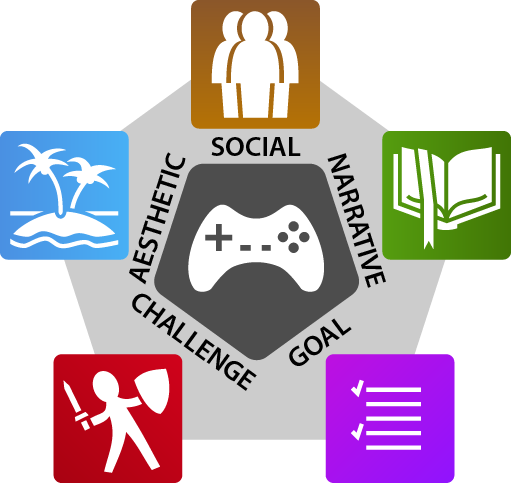A player traits model from the HCI Games Group
The Games User Research (GUR) community has been collectively working towards understanding how player preferences and experiences can be understood and classified. A validated model of player motivations and behaviours can help game designers create games better targeted to their audience. But despite the efforts of the community and the recent advances, we still lack a definitive player traits model and a validated survey to score people on each trait. Therefore, after years of research, the HCI Games Group developed a new Five-Factor Player Traits Model, based on the existing literature and our own research studies.Our traits model introduces a new way to understand how people like to play video games. We created a survey that measures five "player traits": how much players enjoy game visuals (Aesthetic Orientation), stories (Narrative Orientation), completing goals (Goal Orientation), playing with others (Social Orientation), and facing challenges (Challenge Orientation). Unlike older models that put players into strict categories, this approach recognizes that people can have varying levels of each trait. We tested our recent survey with over 300 gamers to make sure it was accurate and reliable.

This model measures how much players like five different gameplay styles. Each person gets a unique score for each trait. So, a full player profile has scores for all traits. You can get your player profile by taking the player traits survey below.Our main study found some interesting connections between these player traits and other factors. For example, people who enjoy game visuals tend to like exploring game worlds and playing alone. Those who like game stories are often more introverted. Goal-oriented players are usually more organized in real life. Social players tend to be more outgoing and friendly. And challenge-seeking players enjoy most game styles except for casual games. However, we note that these connections are not always very strong. Personality alone doesn't fully explain a person's gaming preferences.Our new model of player traits could be useful for game designers, marketers, and researchers. Game designers could use it to create games that better match what players want. Marketers could use it to promote games to the right audiences. And researchers could use it to better understand why people enjoy different types of games. We have made our survey freely available, so anyone can use it to learn more about player preferences. Hopefully, our work lets you understand the many ways people can enjoy video games.
The five traits in the model are
Social orientation

These players prefer gaming with others. They enjoy multiplayer games, cooperative challenges, and competitive gaming communities. Players with low social orientation tend to prefer solo gaming experiences.
Aesthetic orientation

Players who score high on this trait enjoy the visual and auditory experiences in games. They like exploring game worlds, appreciating scenery, and admiring high-quality graphics and sound design. These players often prefer role-playing and simulation games, and they usually enjoy playing alone.
Narrative orientation

These players love complex stories and deep narratives in games. They enjoy games with rich lore and engaging plotlines. Players scoring low on this trait might skip cutscenes or dialogue, feeling that story gets in the way of gameplay. Role-playing and simulation games are favourites for narrative-oriented players.
Challenge orientation

Challenge-oriented players seek out difficult games and hard-to-overcome obstacles. They often play games on the highest difficulty settings and enjoy mastering complex game mechanics. Players scoring low on this trait tend to prefer easier or more casual gaming experiences.
Goal orientation

Goal-oriented players like completing objectives and achieving 100% completion in games. They enjoy collecting items, finishing all side quests, and unlocking all achievements. Players scoring low on this trait are more likely to leave optional tasks unfinished.
Take the test
Would you like to know your player traits profile? Take our player traits scale survey!
Publications
The following publications present our player traits research:
- “I don’t fit into a single type”: A Trait Model and Scale of Game Playing Preferences. Gustavo F. Tondello, Karina Arrambide, Giovanni Ribeiro, Andrew Cen, and Lennart E. Nacke. 2019. “I don’t fit into a single type”: A Trait Model and Scale of Game Playing Preferences. In Proceedings of INTERACT 2019, LNCS 11747. Springer. doi:10.1007/978-3-030-29384-0_23
- Player Characteristics and Video Game Preferences. Gustavo F. Tondello and Lennart E. Nacke. 2019. Player Characteristics and Video Game Preferences. In Proceedings of the 2019 Annual Symposium on Computer-Human Interaction in Play – CHI PLAY ’19. Barcelona, Spain. ACM. doi:10.1145/3311350.3347185
- Towards a Trait Model of Video Game Preferences. Gustavo F. Tondello, Deltcho Valtchanov, Adrian Reetz, Rina R. Wehbe, Rita Orji, and Lennart E. Nacke. 2018. Towards a Trait Model of Video Game Preferences. In International Journal of Human–Computer Interaction 34, 8: 732-748. Taylor & Francis. doi:10.1080/10447318.2018.1461765
Use the scale in your research. Please see these summarized instructions to use the scale in your research project: The scale and instructions are available in multiple languages.
The player traits infographic is licenced under a CC BY-NC-ND 4.0 licence by the HCI Games Group, using icons licenced under a CC BY 3.0 licence from game-icons.net.
